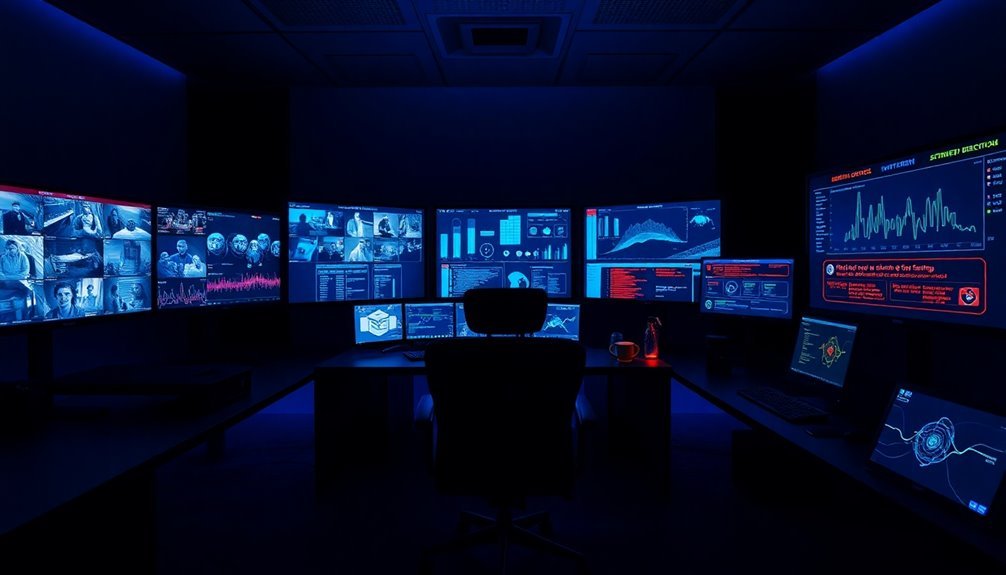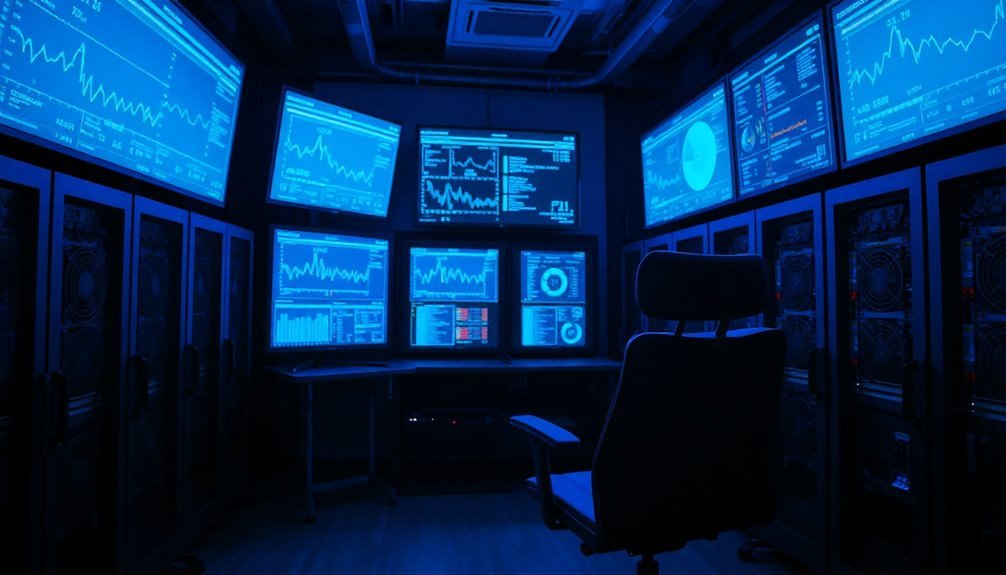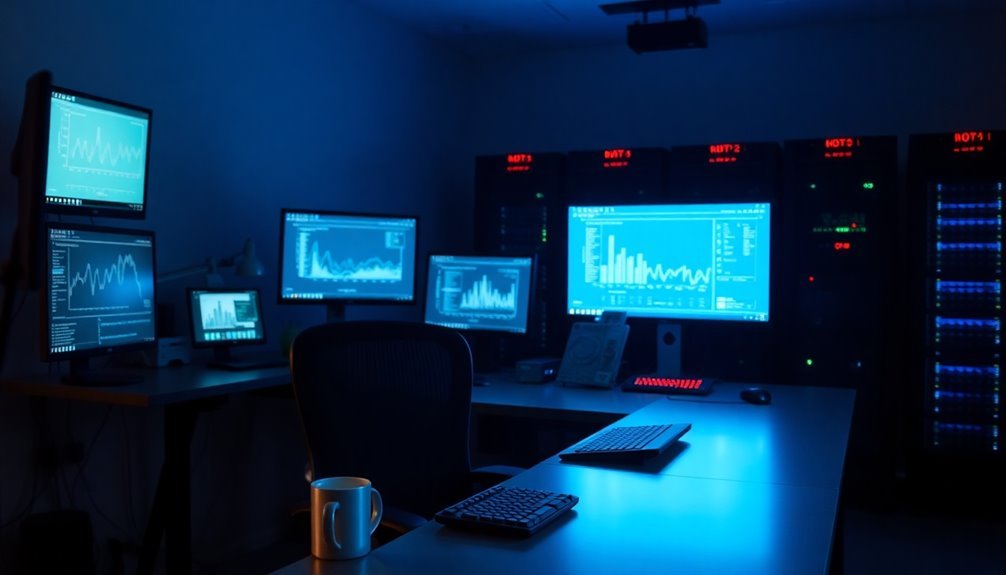You'll want to monitor your computer workstations 24/7 to protect against cyber threats and optimize system performance. Through continuous surveillance, you can detect suspicious activities, prevent data breaches, and respond swiftly to security incidents. Real-time monitoring helps you track resource usage, maintain hardware health, and identify potential failures before they occur. With automated alerts and predictive analysis, you can address issues proactively while ensuring regulatory compliance. Modern monitoring solutions integrate AI and machine learning to enhance threat detection and streamline system management. There's much more to discover about safeguarding your digital assets effectively.
Real-Time Threat Prevention and Detection

Real-time threat prevention and detection serves as a cornerstone of modern computer workstation security. Through continuous monitoring of your network traffic and system behavior, you'll establish a baseline of normal activity that helps identify potential threats immediately. Behavioral analysis techniques help establish patterns of normal operations and quickly flag suspicious deviations.
By integrating advanced security tools with AI and machine learning capabilities, you can enhance your ability to recognize suspicious patterns and predict potential attacks.
You'll receive automated alerts whenever the system detects anomalies in network activity or user behavior, allowing for swift response to emerging threats. This immediate notification system helps prevent data breaches and network compromises before they cause substantial damage.
With SIEM tools aggregating and analyzing log data in real-time, you'll maintain an extensive view of your network's security status.
The benefits extend beyond basic protection. You'll save considerably on operational costs by preventing expensive downtime and avoiding regulatory penalties.
Whether it's detecting cloud account hijacking attempts or monitoring internal network movements, real-time threat detection provides robust security without excessive expenses. By identifying both known and unknown threats as they emerge, you'll maintain a strong security posture while protecting your valuable digital assets.
Workstation Performance Optimization
You'll want to regularly track your workstation's resource usage, monitoring CPU, memory, and disk utilization to identify performance bottlenecks and optimize system efficiency.
By keeping tabs on hardware health metrics like temperature, fan speeds, and disk status, you can prevent potential failures and maintain peak performance levels. Regular inspection helps ensure your computer stays clean and free of accumulated dust that can impact cooling and overall system performance.
Real-time speed monitoring tools help you spot sudden performance drops and take immediate action, ensuring your workstation consistently operates at its best.
Resource Usage Analysis
System administrators and IT professionals rely on resource usage analysis to optimize workstation performance and maximize efficiency. You'll need to monitor key metrics like CPU usage, memory consumption, disk I/O, and network performance to identify potential bottlenecks and resource-intensive applications.
Using tools like Resource Monitor (Resmon), you can track real-time performance data and analyze specific process resource usage. You'll get thorough CPU usage graphs and detailed information about memory-intensive applications, helping you make informed decisions about resource allocation and optimization. The report output includes detailed pie charts that break down utilization levels from very low to high for each monitored resource.
To evaluate workstation utilization effectively, you should focus on active production time and exclude maintenance periods. You can use various methods to collect this data, including stopwatch observations and system control unit readings.
The VDI Resource Usage Desktop Distribution report provides customizable views by zone, service, or segment, allowing you to drill down into specific resource consumption patterns.
When you're optimizing performance, it's essential to regularly monitor these metrics and implement strategies to address identified bottlenecks. You'll want to pay special attention to disk response times, network transfer rates, and process optimization opportunities to maintain peak workstation efficiency.
Hardware Health Tracking
Maintaining top hardware health requires thorough monitoring of essential components in your workstation environment.
You'll need to track temperatures across your CPU, motherboard, and GPU while utilizing S.M.A.R.T. technology to monitor hard drive temperatures. This real-time temperature monitoring helps you prevent permanent hardware damage from overheating. These tools provide user-friendly visual displays through graphs and charts to help you easily interpret temperature data.
Your power supply's health is equally vital. You'll want to monitor voltage levels consistently to identify any fluctuations that could lead to system failures. By tracking power supply performance, you're ensuring stable operation and avoiding unexpected shutdowns.
Your cooling system's effectiveness depends on proper fan operation. You should monitor fan speeds regularly to detect any malfunctions that could compromise your system's cooling capacity. When fans aren't performing effectively, your workstation becomes vulnerable to heat-related issues.
To tie it all together, you'll benefit from thorough system health reporting. These detailed reports provide historical data and immediate alerts when components show signs of potential failure.
You can customize notification profiles to match your needs and use this information to implement preventive maintenance before minor issues become major problems. This proactive approach helps maintain top-notch workstation performance and extends hardware life.
Real-Time Speed Monitoring
Beyond hardware health, real-time speed monitoring forms the backbone of workstation performance optimization. You'll gain immediate insights into CPU usage, memory allocation, and disk performance, allowing you to identify potential bottlenecks before they impact productivity.
By tracking these metrics continuously, you can spot unusual patterns that might indicate system stress or inefficient resource utilization. Custom dashboards provide clear visualizations of hardware health status to simplify performance tracking.
Real-time monitoring helps you optimize your workstation's performance through data-driven decisions. You'll receive instant alerts when system resources exceed predetermined thresholds, enabling swift intervention before problems escalate.
The detailed performance data lets you analyze traffic flows and resource usage patterns, helping you fine-tune configurations for maximum efficiency.
You can leverage historical data analysis to identify recurring performance issues and implement proactive solutions. This approach helps you optimize bandwidth allocation, improve application configurations, and enhance overall system performance.
Data Protection and Security Measures

Three core pillars form the foundation of effective data protection and security measures for computer workstations: technical safeguards, access controls, and physical security protocols.
To establish robust technical safeguards, you'll need to maintain regular software updates, implement firewalls, and deploy anti-virus solutions. Don't forget to encrypt sensitive data and schedule automated backups to secure locations. These measures form your first line of defense against cyber threats. Monitoring network traffic helps detect and prevent potential security breaches early.
For access controls, you must implement multi-factor authentication and role-based access restrictions. You'll want to enforce strong password policies and provide thorough security training to your employees.
Regular security audits will help you identify and address potential vulnerabilities before they're exploited.
Physical security requires securing workstation locations with locks and surveillance cameras. You should limit access to external storage devices and implement strict policies for offline data storage. When necessary, conduct physical security searches to prevent unauthorized device usage.
To complete your security framework, develop clear incident response plans and establish data retention policies. If you're managing remote workstations, guarantee VPN usage for all connections. Remember to maintain detailed privacy policies that outline your data protection practices.
Remote Monitoring Capabilities
Modern remote monitoring tools empower IT teams with thorough oversight of computer workstations from anywhere in the world. You'll benefit from real-time performance metrics that track CPU, memory usage, and input/output, allowing immediate intervention when issues arise.
The system automatically alerts you to potential problems before they escalate into serious disruptions, helping prevent costly downtime. Regular monitoring helps reduce maintenance costs by up to 40 percent through prevention.
You can manage diverse IT assets across multiple platforms, including Windows, macOS, and Linux, from a unified console. The solution's scalability guarantees it grows alongside your IT environment, while supporting various devices from workstations to servers.
You'll appreciate the dual-screen and multi-monitor support, which enhances productivity in remote desktop environments.
The cost-efficiency of remote monitoring is substantial. You'll reduce expenses by minimizing on-site visits and automating routine tasks like bulk updates and patch management. Your IT team can focus on strategic work while the system handles day-to-day monitoring.
Through centralized control and automated alerts, you'll maintain top system performance while efficiently allocating resources. This proactive approach guarantees your workstations operate at peak efficiency around the clock.
System Health and Maintenance

While remote monitoring provides digital oversight, maintaining the highest system health requires a combination of physical and software care.
You'll need to regularly remove dust from your computer components and maintain proper cooling systems to prevent overheating. Every 3-6 months, clean your cooling fans, and replace thermal paste every 2-3 years to ensure top performance. Following these maintenance steps will help achieve extended hardware lifespan.
Your software maintenance is equally pivotal. Schedule weekly antivirus scans and install system updates at least monthly to protect against security vulnerabilities. Don't forget to manage your startup programs and run regular disk cleanups to maintain system speed. You should also monitor your system's performance using task manager tools to catch potential issues early.
Data management plays an essential role in system health. Set up automatic backups to both local and cloud storage, and regularly test these backups to ensure they're working correctly.
You'll want to maintain adequate free space by removing unnecessary files and uninstalling unused programs. Remember to organize your workstation ergonomically, with proper monitor positioning and cable management, as this prevents dust accumulation and ensures peak airflow around your system.
Cost-Effective IT Management Solutions
Effective IT management doesn't need to drain your budget when you implement smart, cost-saving strategies. By leveraging cloud-based ITSM solutions and automated processes, you'll reduce operational costs while maintaining high service quality. You can optimize your existing resources and implement proactive maintenance to prevent costly downtime.
Consider deploying dual monitors across your workstations – a simple yet powerful productivity enhancement that can boost efficiency by up to 50%. This setup allows your team to multitask effectively while reducing the time spent switching between applications.
| Cost-Saving Solution | Primary Benefit | ROI Impact |
|---|---|---|
| Cloud-Based ITSM | Scalable Operations | Reduced Infrastructure Costs |
| Managed IT Services | Proactive Maintenance | Lower Downtime Expenses |
| Dual Monitor Setup | Enhanced Productivity | Increased Work Efficiency |
Partner with managed IT service providers to access tailored, scalable solutions that fit your budget. You'll benefit from their expertise in implementing cost-effective technologies and maintaining robust cybersecurity measures. By utilizing remote support capabilities and SaaS solutions, you can substantially reduce travel costs and hardware expenses while ensuring your IT infrastructure remains agile and responsive to changing business needs.
Regulatory Compliance Assurance

Regulatory compliance for computer workstations demands a structured approach to meet industry-specific requirements and protect sensitive data. You'll need to adhere to regulations like HIPAA, PCI DSS, or GDPR, depending on your industry and location.
Regular assessments and monitoring are vital to identify vulnerabilities and maintain compliance with these standards.
You must implement robust security measures, including firewalls, encryption, and access controls, to protect your data and meet regulatory requirements. While the ECPA and Stored Communications Act confirm your right to monitor company-owned devices, you should inform employees about your monitoring practices to maintain transparency and legal compliance.
To guarantee ongoing compliance, you'll need to conduct thorough audits, perform risk assessments, and maintain strict access controls through measures like two-factor authentication.
Don't forget to keep your software updated with security patches to address vulnerabilities. The consequences of non-compliance can be severe, including hefty fines, legal action, and damage to your reputation.
Network Security Enhancement
Your network security relies heavily on robust monitoring systems that can quickly detect and prevent threats through continuous surveillance of workstation activities.
You'll receive real-time security alerts when suspicious activities occur, allowing for immediate response to potential breaches before they escalate into major security incidents.
Through effective access control management, you can restrict unauthorized users, control permissions, and maintain detailed logs of who accesses what resources on your network.
Threat Detection and Prevention
Modern threat detection and prevention requires a multi-layered approach to protect computer workstations from evolving cyber threats. You'll need to implement various detection techniques, including Network Detection and Response (NDR) for monitoring suspicious traffic, and Endpoint Detection and Response (EDR) for continuous endpoint monitoring and automated responses.
To strengthen your security posture, you'll want to utilize Extended Detection and Response (XDR) to identify and remediate threats across multiple security layers. This includes monitoring email communications, cloud workloads, and network endpoints.
You should also implement vulnerability management processes to identify and address both known and unknown system vulnerabilities.
Don't forget to incorporate network security enhancements like segmentation and DMZs to contain potential threats. You'll need to use private IP addresses and maintain strict access control measures while conducting regular security audits.
It's crucial to maintain continuous security monitoring through IDS and IPS systems, coupled with thorough network traffic analysis. By automating these security processes and integrating your security tools, you'll improve your threat detection efficiency and response times while ensuring compliance with regulatory requirements.
Real-time Security Alerts
Building on your threat detection framework, real-time security alerts serve as your first line of defense against emerging cyber threats. You'll gain enhanced situational awareness through continuous monitoring of your IT systems, allowing you to identify and respond to potential threats instantly. These alerts enable your team to adopt a proactive stance, substantially reducing the time threats remain undetected in your network.
With automated incident response capabilities, you'll benefit from immediate threat neutralization through predefined actions and rapid system isolation. Your security teams can focus on strategic tasks while automated systems handle routine monitoring and initial response procedures.
| Alert Feature | Security Benefit |
|---|---|
| Real-time Monitoring | Instant threat detection and continuous visibility |
| Automated Response | Immediate threat containment and system isolation |
| Customizable Triggers | Focused attention on priority security concerns |
| Multi-channel Notifications | Rapid team communication and response |
You can customize alert thresholds and notification methods to match your organization's specific needs. This tailored approach guarantees you're focusing on the most critical security concerns while maintaining efficient resource allocation. Through proactive problem prevention, you'll minimize system downtime and maintain top network performance.
Access Control Management
Security excellence starts with robust access control management – the cornerstone of network protection. You'll need both Network Access Control (NAC) and Access Control Lists (ACLs) to create a formidable defense against unauthorized access and potential threats.
By implementing these controls, you'll gain granular-level oversight of your network resources while enforcing strict access policies that protect your sensitive data.
Your NAC system will continuously assess device security status, verify user identities, and integrate with your existing security infrastructure like firewalls and SIEM systems.
Meanwhile, ACLs will help you steer network traffic and define specific permissions for different user groups.
You'll sleep better knowing your network automatically blocks unauthorized access attempts and prevents privilege escalation.
You'll feel confident that your organization maintains compliance with regulations like GDPR and HIPAA.
You'll experience peace of mind with real-time visibility into all network activity and connected devices.
Through thorough access control management, you're not just monitoring workstations – you're creating an intelligent security ecosystem that protects your organization around the clock while streamlining user authentication and device registration processes.
Predictive Analysis and Issue Resolution

Three critical components define effective predictive analysis in computer workstation monitoring: data collection, pattern recognition, and proactive maintenance.
Modern predictive tools continuously track crucial metrics like CPU usage, memory allocation, temperature levels, and disk performance to establish baseline behaviors and identify potential issues early.
By leveraging historical data and statistical algorithms, you can spot deviations from normal operations before they escalate into serious problems. The system's dashboard will alert you when specific thresholds are crossed, enabling you to schedule maintenance during convenient times rather than dealing with emergency repairs.
You'll benefit from improved operational efficiency as predictive analytics helps you optimize resource allocation and reduce unnecessary parts inventory. The integration of AI and machine learning enhances prediction accuracy, while automation features simplify the analysis process.
Whether you're using Microsoft Azure Machine Learning, SAP Predictive Analytics, or similar tools, you'll have access to prebuilt models and templates that streamline issue resolution. These solutions support both basic monitoring needs and advanced analytics, ensuring you can maintain maximum system uptime while minimizing unexpected downtime through data-driven decision-making.
Frequently Asked Questions
How Long Does It Take to Set up 24/7 Workstation Monitoring?
You'll need 2-4 hours for basic setup, but it can take 1-2 days when monitoring multiple workstations. Your chosen tool, network complexity, and customization requirements will affect the total setup time.
Can Employees Disable Monitoring Tools on Their Workstations?
Yes, technically skilled employees can disable monitoring tools through various methods like mouse jigglers, leaving idle windows open, or blocking the software. However, you'll detect these attempts through regular security checks and anti-tampering measures.
Does Workstation Monitoring Affect Computer Speed or Performance?
Workstation monitoring won't substantially impact your computer's speed or performance. Today's monitoring tools are designed to run efficiently, using minimal CPU, memory, and network resources while operating in the background.
What Happens if Internet Connectivity Is Lost During Monitoring?
When you lose internet connectivity, your monitoring system will store data locally on your workstation. Once the connection's restored, it'll automatically sync the cached information back to the central monitoring server.
Are Personal Devices Covered Under Workplace Monitoring Systems?
You can't monitor personal devices without consent and proper BYOD policies. You'll need explicit permission from employees, and monitoring must be limited to work-related activities during business hours on these devices.
In Summary
You'll find that 24/7 workstation monitoring is essential for your organization's security and efficiency. By implementing continuous monitoring, you're protecting against cyber threats, optimizing performance, and ensuring compliance. You're also saving money through preventive maintenance and quick issue resolution. Don't wait for problems to occur – proactive monitoring gives you peace of mind and keeps your business running smoothly around the clock.





Leave a Reply